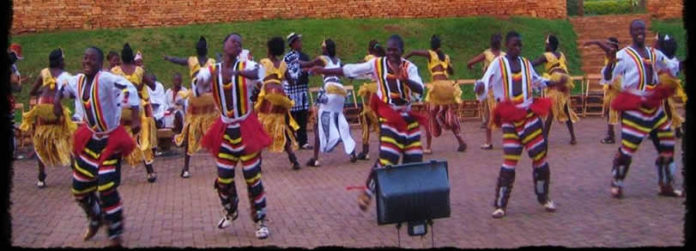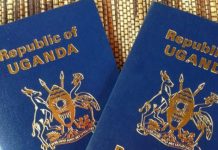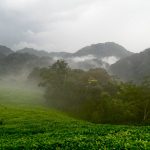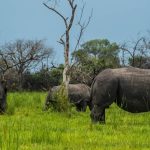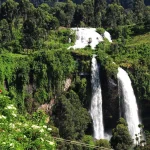National Parks
There are three main categories of Uganda’s wildlife protected areas namely National Parks, Wildlife Reserves, and Forest Reserves. The conservation and management of these areas is controlled by the Uganda Wildlife Authority and the National Forest Authority both under the under the Ministry of Tourism Wildlife and Antiquities. Uganda has 10 established national parks allowing tourists to savor Uganda’s environment.
Queen Elizabeth National Park – The Queen Elizabeth The Queen Elizabeth National Park, famous for most safaris in Uganda, has been designated a Biosphere Reserve for Humanity under UNESCO auspices. Queen Elizabeth covers 2,056 sq. km and includes ecosystems, from semi-deciduous tropical forest to green meadows, savannah and swamps. The park, in the western arm of the Great East African Rift Valley is the home of the Uganda Kob, the famous tree-climbing Ishasha lions as well as , other hippos, buffalo, antelope species, elephant, baboons and chimpanzees. There are over 500 species of birds that have been recorded, making the park a magnet for bird watchers.
Bwindi Impenetrable Forest – The park with its dense ground cover of vines and shrubs is home to the world famous mountain gorillas, of which they are less than 600 still left in the entire world. Gorilla permits are required for tracking the gorillas and it is, therefore, advisable to make reservations at least three months in advance. Bwindi is one of the richest areas for flora in Eastern Africa. The forest is also sanctuary for Columbus monkeys, chimpanzees and many bird types including some endangered species.
Mgahinga Gorilla – This is yet another haven for the persecuted mountain gorilla. Located on the slopes of the Virunga Mountains, in the extreme southwest corner of Uganda, the park has been set aside to provide a secure habitat for the gorillas. However, besides the gorillas, other wildlife may also be viewed including the leopard, giant forest hog, bushbuck, buffalo, and golden monkey. The summit of Mount Muhavura (4,127 m) has a small crater lake.
Kibale Forest National Park – The rainforest is situated to the north-east of Queen Elizabeth National Park. In addition to forest, there are also areas of grassland and swamp. The park is noted for its primate population – 13 different species inhabit the park including many families of chimpanzees and several types of Columbus monkeys. Bushbuck, waterbuck, duiker and giant forest hog may also be seen. The forests and the grasslands support abundant bird life – almost 300 species have been identified and 144 types of butterfly.
Kidepo National Park – Kidepo Valley National park is located in Kaabong District, in the northeastern corner of Uganda. The park is located approximately 220 kilometres (140 mi), by road northwest of Moroto, the largest town in the sub-region. Its location is approximately 520 kilometres (320 mi), by road, northeast of Kampala, Uganda’s capital and largest city.
The northwestern boundary of the park runs along the international frontier with South Sudan and abuts against the Kidepo Game Reserve.. It is inhabited by various wildlife including elephant, buffalo, lion, leopard, cheetah, giraffe, various antelope species, baboon, bushbaby and over 200 species of bird. Two game viewing routes connect the rest camp with the prime wildlife areas near the Winwing River and the rock escarpment to the southwest. On the park’s northern borders are the Kananorok Hot Springs. In 2013, it was nominated as Africa’s leading National Park by travel wards
Mount Elgon – This is an extinct volcano located on Uganda’s eastern border. The mountain boasts numerous interesting features including gorges, ancient caves, water falls and hot springs. Birdlife is abundant on the mountain although various wildlife may also be encountered.
Semuliki National Park – This is the only park in Uganda to be composed primarily of tropical lowland forest. The forest is very dense and quite flat, creating a startling contrast to the rugged Rwenzori Mountains nearby. The Semliki River attracts many animals. The park is home to eight species of primate, 400 birds and 300 butterfly species. Elephant, buffalo, leopard, civet, bushbaby and flying squirrels are also found.
Lake Mburo National Park – Situated between the towns of Masaka and Mbarara, this comparatively small park (371 sq. km) is composed primarily of grassland, wetland and acacia woodland. At the centre lies the Lake Mburo, which together with 14 other lakes, forms part of an extensive wetland area. Animals to be found in the park include the impala, eland, rock hyrax, zebra, waterbuck, buffalo, warthog, leopard, civet, hyena, hippo, and crocodile. There are also over 357 species of birds including the marabou stock and the crowned crane.
Rwenzori Mountains –The mist-shrouded peaks of the Mountains of the Moon provide a stunning backdrop to this magnificent park, located on Uganda’s western border. In the centre of the range, some of the peaks are permanently covered in snow and glaciers, while the lower slopes are covered with dense forests.
Here is the third highest mountain in Africa, Mt. Magherita, which rises to 5,100 metres above sea level. Walking tours in the foothills are a feature, although only the experienced and fit should attempt an ascent on the peaks, which rival the Alps in difficulty.
Some of the wildlife to be found in the mountains include the chimpanzees, along with the blue monkey, hyrax, giant forest hog and many unique bird species such as the Rwenzori touraco, the francolin and the olive pigeon.
The Rwenzoris are the legendary “Mountains of the moon”, a reflection of the mist-shrouded mountains of this rugged massif that tower almost 4,000 m above the Albertine Rift Valley, making them visible from great distances. These mountains offer a unique and pristine landscape of alpine vegetation studded with charismatic giant lobelias, groundsels, and heathers which have been called “Africa’s botanical big game”.
The combination of spectacular snow-capped peaks, glaciers, V-shaped valleys, fast flowing rivers with magnificent waterfalls, clear blue lakes and unique flora contributes to the area’s exceptional natural beauty.
Significant species include the giant heathers, groundsels, lobelias and other endemics. In terms of fauna, the Rwenzoris have been recognised as an Important Bird Area with 217 bird species recorded to date, a number expected to increase as the park becomes better surveyed. The montane forests are also a home to threatened species such as the African forest elephant, eastern chimpanzee and l’Hoest’s monkey. The endangered Rwenzori black-fronted or red duiker, believed to be a very localized subspecies or possibly a separate species, appears to be restricted to the Park.
